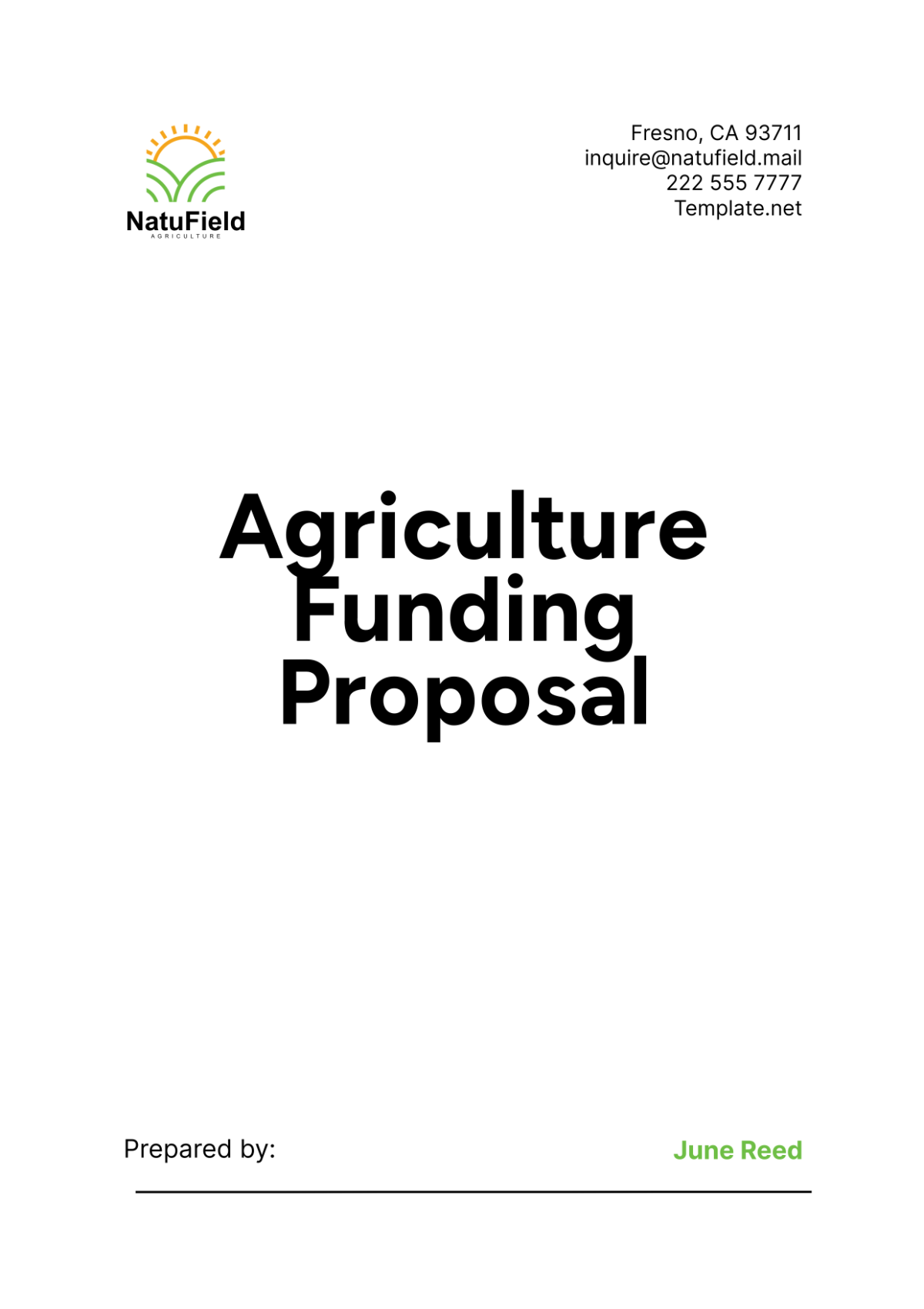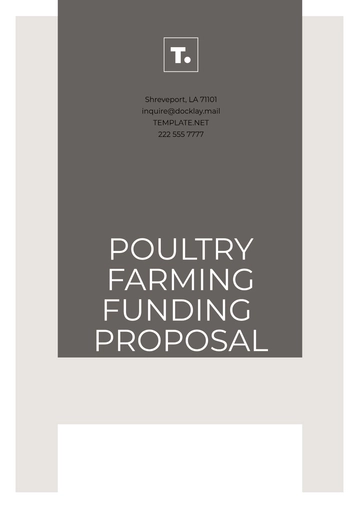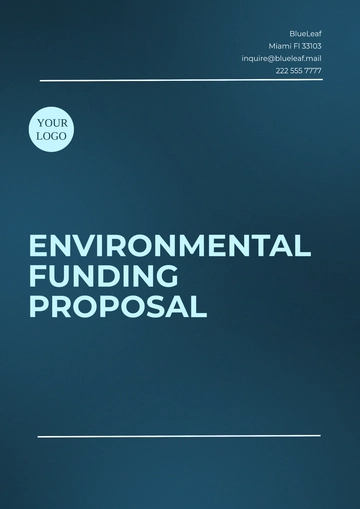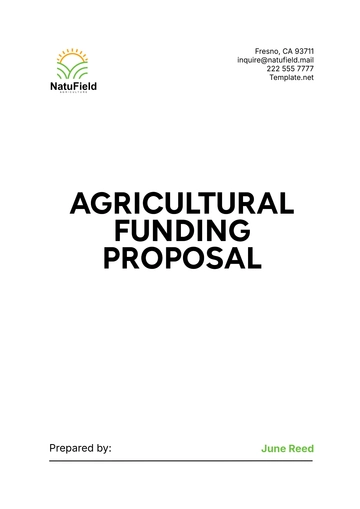Free Agriculture Funding Proposal

I. Executive Summary
A. Introduction
[Your Company Name] presents this proposal to secure funding for an ambitious agricultural project aimed at transforming traditional farming practices into sustainable and high-yield methods. Our initiative seeks to address key challenges in the agricultural sector such as soil degradation, water scarcity, and low productivity. By integrating advanced technologies and modern farming techniques, we aim to enhance crop yields, improve soil health, and promote environmental sustainability.
B. Objectives
Increase Crop Production: Our primary goal is to achieve a 20% increase in crop production within the first two years of project implementation through the adoption of innovative farming practices.
Enhance Water Efficiency: We plan to reduce water usage by 15% by implementing state-of-the-art irrigation systems that optimize water distribution and minimize wastage.
Promote Soil Health: Utilizing organic farming methods, we aim to improve soil fertility and structure, thereby ensuring sustainable agricultural practices for long-term productivity.
Community Development: Through job creation and training programs, we aim to enhance the socio-economic well-being of local communities, contributing to rural development and economic growth.
C. Project Scope
The proposed project will span over a five-year period and encompass an initial cultivation area of 1,000 acres. It will involve the cultivation of high-value crops such as vegetables, fruits, and herbs, alongside the installation of advanced irrigation systems and the use of organic fertilizers and pest control methods. The project will also include comprehensive training programs for local farmers to equip them with the skills necessary for sustainable farming practices. Additionally, a robust supply chain will be established to ensure efficient distribution and marketing of the produce.
D. Funding Requirements
[Your Company Name] seeks a total funding of $5,000,000 to cover various project components, including land acquisition, infrastructure development, equipment purchase, training programs, and operational expenses for the initial two years of implementation.
II. Project Description
A. Background
The global agricultural sector faces significant challenges, including the need for increased food production to meet the demands of a growing population, environmental sustainability, and the impacts of climate change. Traditional farming methods often contribute to soil degradation, water depletion, and environmental pollution. [Your Company Name] aims to address these challenges by implementing sustainable farming practices that maximize productivity while minimizing environmental impact.
B. Project Goals
Sustainable Agriculture: Implementing eco-friendly farming practices such as organic farming, integrated pest management (IPM), and precision agriculture to minimize chemical inputs and environmental impact.
Technology Integration: Leveraging advanced technologies such as IoT (Internet of Things), drones, and data analytics to monitor crop health, optimize resource allocation, and enhance decision-making processes.
Water Conservation: Installing drip irrigation systems and rainwater harvesting techniques to conserve water resources and improve irrigation efficiency.
Community Empowerment: Providing training and capacity-building programs for local farmers to enhance their agricultural skills, promote entrepreneurship, and improve livelihoods.
C. Project Components
1. Land Preparation
Location and Selection: The project will be situated in [Location], chosen for its fertile soil quality, favorable climate conditions, and proximity to local markets.
Soil Analysis: Prior to cultivation, comprehensive soil testing will be conducted to assess nutrient levels, pH balance, and soil structure. This analysis will guide crop selection and determine suitable fertilization practices.
2. Infrastructure Development
Irrigation Systems: The project will implement advanced irrigation systems including drip irrigation and sprinklers, designed to deliver water directly to the plant roots while minimizing evaporation and runoff.
Storage Facilities: Construction of modern storage facilities to preserve harvested crops, maintain quality, and reduce post-harvest losses.
3. Crop Cultivation
Crop Selection: High-value crops such as tomatoes, bell peppers, strawberries, and herbs will be selected based on market demand, climate suitability, and profitability.
Organic Farming Practices: Utilization of organic fertilizers, compost, and biocontrol agents to improve soil fertility, enhance crop resilience to pests and diseases, and promote environmental sustainability.
4. Training and Capacity Building
Farmers' Training Programs: Implementation of workshops, seminars, and field demonstrations to educate local farmers on modern farming techniques, sustainable practices, and the use of agricultural technologies.
Skill Enhancement: Training programs will focus on soil management, crop rotation, pest control, water conservation, and the use of farm machinery and equipment.
5. Market Development
Supply Chain Management: Development of efficient supply chains linking farmers to local markets, supermarkets, restaurants, and export channels.
Market Access: Strategic partnerships with agricultural cooperatives, retailers, and export agents to facilitate market access and enhance profitability for farmers.
D. Implementation Plan
The project will be executed in phases over a five-year timeline, ensuring systematic implementation and monitoring of project milestones:
Year 1: Project Initiation and Setup
Land acquisition and preparation, including soil testing and initial infrastructure development.
Installation of irrigation systems and commencement of crop cultivation trials.
Year 2: Expansion and Consolidation
Expansion of cultivated area based on successful crop trials and market demand.
Intensification of training programs and capacity building for farmers.
Year 3: Full-Scale Operations
Full deployment of sustainable farming practices and technologies across the project area.
Optimization of irrigation systems and crop management practices to maximize productivity.
Year 4: Scaling and Market Penetration
Scaling up production to meet market demands and expanding market reach through strategic partnerships.
Continuous monitoring of soil health, water usage, and crop performance to ensure sustainability.
Year 5: Sustainability and Community Integration
Implementation of long-term sustainability measures, including soil conservation practices and biodiversity management.
Gradual transition of project management to local communities and stakeholders.
III. Market Analysis
A. Industry Overview
The global agriculture industry is witnessing a paradigm shift towards sustainable practices and technological innovations to address food security challenges and environmental sustainability. There is an increasing demand for organic and locally grown produce, driven by consumer awareness of health benefits and environmental concerns.
B. Target Market
The primary target market for [Your Company Name]'s agricultural produce includes local consumers, supermarkets, restaurants, and export markets. The focus will be on high-value crops that command premium prices in domestic and international markets.
C. Competitive Analysis
The competitive landscape in the agricultural sector is diverse, with numerous players ranging from small-scale farmers to large agribusiness corporations. However, there is a niche market opportunity for sustainable and organic produce, where [Your Company Name] aims to differentiate itself through innovative farming practices, product quality, and market responsiveness.
D. SWOT Analysis
1. Strengths
Expertise in Sustainable Farming: [Your Company Name] has a proven track record in implementing sustainable farming practices and leveraging technological advancements.
Strategic Location: The project's location offers fertile soil, favorable climate conditions, and proximity to urban markets, enhancing market accessibility and reducing transportation costs.
Strong Community Support: Local community engagement and support enhance project acceptance, operational efficiency, and long-term sustainability.
2. Weaknesses
Initial Capital Investment: The project requires substantial initial investment for land acquisition, infrastructure development, and technology deployment.
Market Volatility: Fluctuations in market prices and consumer demand for organic produce pose risks to profitability and financial stability.
3. Opportunities
Growing Demand for Organic Products: Increasing consumer preference for organic and sustainably produced food presents a lucrative market opportunity.
Government Incentives: Supportive policies and incentives promoting sustainable agriculture and rural development provide additional funding and operational advantages.
Export Potential: Access to international markets offers potential for export growth and revenue diversification.
4. Threats
Competitive Pressure: Intense competition from established agricultural producers and suppliers may impact market share and pricing.
Climate Change: Environmental factors such as droughts, floods, and extreme weather events can affect crop production and yield stability.
Regulatory Challenges: Compliance with evolving environmental regulations, food safety standards, and trade barriers poses regulatory risks.
IV. Technical Plan
A. Land Acquisition and Preparation
Location Selection: The project site will be strategically chosen based on soil fertility, water availability, and proximity to markets to optimize agricultural productivity and economic viability.
Land Use Planning: Comprehensive land use planning will be conducted to maximize land utilization, minimize environmental impact, and ensure long-term sustainability.
B. Infrastructure Development
Irrigation Systems
Drip Irrigation: Installation of drip irrigation systems to deliver precise amounts of water directly to plant roots, reducing water consumption and enhancing nutrient uptake.
Smart Irrigation Technology: Integration of IoT-enabled sensors and controllers for real-time monitoring of soil moisture levels and weather conditions to optimize irrigation scheduling and water efficiency.
Storage and Processing Facilities
Construction of modern storage facilities equipped with climate control and refrigeration systems to maintain product quality and extend shelf life.
Establishment of processing units for value-added products such as jams, sauces, and dried herbs to capitalize on market demand and increase revenue streams.
C. Crop Cultivation
Crop Selection
Selection of high-value crops such as strawberries, tomatoes, bell peppers, and culinary herbs based on market demand, consumer preferences, and agro-climatic suitability.
Crop diversification and rotation to improve soil health, reduce pest infestations, and enhance farm resilience to climate variability.
Sustainable Farming Practices
Adoption of organic farming techniques including crop rotation, cover cropping, and composting to improve soil structure, fertility, and biodiversity.
Implementation of integrated pest management (IPM) strategies using biological control agents, trap crops, and natural predators to minimize pesticide use and environmental impact.
D. Training and Capacity Building
Farmers' Training Programs
Implementation of comprehensive training programs and workshops for local farmers on sustainable farming practices, soil management, pest control, and crop nutrition.
Capacity building in farm mechanization, equipment operation, and maintenance to improve productivity, reduce labor costs, and enhance operational efficiency.
Community Engagement
Establishment of farmer cooperatives and producer groups to foster collective marketing, bargaining power, and knowledge sharing among local agricultural stakeholders.
Promotion of women's participation in agriculture through targeted training and empowerment initiatives to enhance gender equality and social inclusivity.
E. Market Development
Supply Chain Management
Development of efficient supply chains linking farmers to local markets, supermarkets, restaurants, and export markets to ensure timely delivery of fresh, high-quality produce.
Collaboration with logistics providers and cold chain operators to maintain product integrity, minimize post-harvest losses, and meet stringent food safety standards.
Marketing Strategies
Branding and promotion of [Your Company Name]'s produce as premium-quality, locally sourced, and sustainably grown products to differentiate them in competitive markets.
Participation in agricultural trade fairs, food expos, and community events to showcase products, build brand awareness, and attract potential customers and investors.
V. Financial Plan
A. Budget Estimate
The project budget for [Your Company Name]'s agricultural initiative is structured as follows:
Expense Category | Year 1 | Year 2 | Year 3 | Year 4 | Year 5 | Total |
|---|---|---|---|---|---|---|
Land Acquisition | $500,000 | $500,000 | ||||
Infrastructure Development | $1,000,000 | $500,000 | $250,000 | $250,000 | $250,000 | $2,250,000 |
Equipment Purchase | $500,000 | $250,000 | $100,000 | $100,000 | $100,000 | $1,050,000 |
Training Programs | $100,000 | $150,000 | $200,000 | $100,000 | $100,000 | $650,000 |
Operational Expenses | $200,000 | $300,000 | $400,000 | $400,000 | $300,000 | $1,600,000 |
Total | $2,300,000 | $1,200,000 | $950,000 | $850,000 | $750,000 | $6,050,000 |
B. Funding Sources
Government Grants: $2,000,000
Private Investors: $2,500,000
Bank Loans: $1,000,000
Internal Funds: $550,000
C. Financial Projections
The financial projections for [Your Company Name]'s agricultural project are as follows:
Year | Revenue | Expenses | Net Profit |
|---|---|---|---|
1 | $1,000,000 | $2,300,000 | -$1,300,000 |
2 | $2,500,000 | $1,200,000 | $1,300,000 |
3 | $3,500,000 | $950,000 | $2,550,000 |
4 | $4,000,000 | $850,000 | $3,150,000 |
5 | $4,500,000 | $750,000 | $3,750,000 |
D. Risk Management
Market Risks
Diversification of crop portfolio to mitigate risks associated with market price volatility.
Adoption of forward contracts and hedging strategies to manage price fluctuations and ensure stable revenue streams.
Operational Risks
Implementation of contingency plans and disaster management protocols to mitigate risks associated with crop failures, natural disasters, and supply chain disruptions.
Regular maintenance and servicing of agricultural equipment and infrastructure to minimize downtime and operational disruptions.
Financial Risks
Prudent financial management and budgetary controls to ensure effective allocation of funds and adherence to project timelines.
Secure long-term financing arrangements and credit facilities to maintain liquidity and financial stability throughout the project lifecycle.
VI. Project Team
A. Organizational Structure
The project team will comprise a diverse group of professionals with expertise in agriculture, finance, project management, and community development. Key roles and responsibilities include:
Project Manager
Overall project oversight, coordination, and implementation of strategic initiatives.
Stakeholder engagement and communication to ensure alignment with project goals and objectives.
Agronomist
Technical expertise in soil management, crop selection, and pest control strategies.
Monitoring and evaluation of agricultural practices to optimize crop yield and quality.
Irrigation Specialist
Design and implementation of efficient irrigation systems and water management strategies.
Monitoring and optimization of water usage to enhance irrigation efficiency and crop productivity.
Community Liaison Officer
Engagement with local communities, stakeholders, and government agencies to promote project awareness and participation.
Facilitation of training programs, workshops, and capacity-building initiatives to empower local farmers and enhance community livelihoods.
Financial Analyst
Financial planning, budgeting, and forecasting to support project feasibility and financial sustainability.
Monitoring and reporting of financial performance, expenditures, and budget variances to stakeholders and funding partners.
B. Roles and Responsibilities
Team Member | Roles and Responsibilities |
|---|---|
Project Manager | Overall project management, coordination, and execution |
Agronomist | Technical guidance on crop selection and farming practices |
Irrigation Specialist | Design and implementation of irrigation systems |
Community Liaison Officer | Community engagement and training programs |
Financial Analyst | Financial management, budgeting, and reporting |
VII. Evaluation and Monitoring
A. Monitoring Plan
A robust monitoring and evaluation (M&E) framework will be implemented to assess project progress, measure outcomes, and ensure accountability. Key performance indicators (KPIs) will be established to track the following metrics:
Crop Yield: Measurement of crop production levels and yield per hectare compared to baseline data and industry standards.
Water Usage: Monitoring of water consumption and irrigation efficiency to optimize resource allocation and minimize environmental impact.
Soil Health: Regular soil testing and analysis to assess nutrient levels, pH balance, and organic matter content.
Community Impact: Evaluation of job creation, income generation, and socio-economic benefits for local communities.
B. Evaluation Criteria
Crop Yield and Quality
Assessment of crop productivity, yield stability, and product quality based on market standards and consumer preferences.
Analysis of factors influencing crop performance, including soil fertility, water availability, and pest management practices.
Resource Efficiency
Evaluation of water use efficiency, energy consumption, and resource utilization to optimize operational efficiency and reduce production costs.
Implementation of sustainable farming practices and technologies to enhance resource conservation and environmental sustainability.
Community Empowerment
Monitoring of training program effectiveness, farmer adoption rates of sustainable practices, and improvements in agricultural productivity and income levels.
Feedback from community stakeholders, including farmers, cooperatives, and local organizations, to assess project impact and promote inclusive development.
C. Reporting
Quarterly and annual progress reports will be prepared to document project achievements, challenges, and lessons learned. These reports will include comprehensive data analysis, performance metrics, financial updates, and recommendations for continuous improvement and stakeholder engagement. Regular updates will be provided to funding partners, stakeholders, and regulatory authorities to ensure transparency and accountability.
VIII. Conclusion
A. Summary
[Your Company Name]'s agricultural project represents a transformative initiative to revolutionize farming practices through sustainable agriculture, technological innovation, and community development. By integrating advanced technologies with eco-friendly farming practices, we aim to enhance productivity, conserve natural resources, and promote economic prosperity for local communities.
B. Call to Action
We invite potential investors, funding agencies, and strategic partners to join us in supporting this pioneering project. Together, we can create a sustainable model for agriculture that not only meets the demands of today but also ensures the well-being of future generations. By investing in [Your Company Name]'s agricultural initiative, you are not only contributing to food security and environmental sustainability but also fostering economic growth and social development in rural communities.
C. Contact Information
For further information, partnership opportunities, and inquiries, please contact:
[Your Name]
[Your Position]
[Your Company Name]
[Your Company Address]
[Your Company Phone Number]
[Your Company Email Address]
- 100% Customizable, free editor
- Access 1 Million+ Templates, photo’s & graphics
- Download or share as a template
- Click and replace photos, graphics, text, backgrounds
- Resize, crop, AI write & more
- Access advanced editor
Secure funding for agricultural initiatives with the Agriculture Funding Proposal Template from Template.net. It's customizable and editable, designed for persuasive proposals. Utilize our Ai Editor Tool to outline project details and benefits, attracting investors and securing financial support for agricultural development.
You may also like
- Business Proposal
- Research Proposal
- Proposal Request
- Project Proposal
- Grant Proposal
- Photography Proposal
- Job Proposal
- Budget Proposal
- Marketing Proposal
- Branding Proposal
- Advertising Proposal
- Sales Proposal
- Startup Proposal
- Event Proposal
- Creative Proposal
- Restaurant Proposal
- Blank Proposal
- One Page Proposal
- Proposal Report
- IT Proposal
- Non Profit Proposal
- Training Proposal
- Construction Proposal
- School Proposal
- Cleaning Proposal
- Contract Proposal
- HR Proposal
- Travel Agency Proposal
- Small Business Proposal
- Investment Proposal
- Bid Proposal
- Retail Business Proposal
- Sponsorship Proposal
- Academic Proposal
- Partnership Proposal
- Work Proposal
- Agency Proposal
- University Proposal
- Accounting Proposal
- Real Estate Proposal
- Hotel Proposal
- Product Proposal
- Advertising Agency Proposal
- Development Proposal
- Loan Proposal
- Website Proposal
- Nursing Home Proposal
- Financial Proposal
- Salon Proposal
- Freelancer Proposal
- Funding Proposal
- Work from Home Proposal
- Company Proposal
- Consulting Proposal
- Educational Proposal
- Construction Bid Proposal
- Interior Design Proposal
- New Product Proposal
- Sports Proposal
- Corporate Proposal
- Food Proposal
- Property Proposal
- Maintenance Proposal
- Purchase Proposal
- Rental Proposal
- Recruitment Proposal
- Social Media Proposal
- Travel Proposal
- Trip Proposal
- Software Proposal
- Conference Proposal
- Graphic Design Proposal
- Law Firm Proposal
- Medical Proposal
- Music Proposal
- Pricing Proposal
- SEO Proposal
- Strategy Proposal
- Technical Proposal
- Coaching Proposal
- Ecommerce Proposal
- Fundraising Proposal
- Landscaping Proposal
- Charity Proposal
- Contractor Proposal
- Exhibition Proposal
- Art Proposal
- Mobile Proposal
- Equipment Proposal
- Student Proposal
- Engineering Proposal
- Business Proposal





























